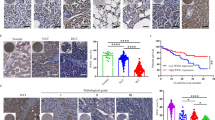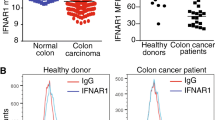Abstract
The objective response rate of immune checkpoint blockade (ICB) in hepatocellular carcinoma (HCC) with anti PD-L1/PD-1 therapy is low. Discovering the signaling pathways regulating PD-L1 might help to improve ICB response rates. Here, we investigate transcription factors IRF-1 and IRF-2 signaling pathways regulating PD-L1 in HCC cells. In vivo studies show that IRF-1 and PD-L1 mRNA expression in human HCC tumors are significantly repressed compared with noncancerous background liver. IRF-1, IRF-2, and PD-L1 mRNA expression correlated positively in HCC tumors. Increased IRF-1 mRNA expression was observed in patients with well-differentiated or early stage HCC tumors. In vitro studies show that IFN-γ induces PD-L1 mRNA and protein expression through upregulation of IRF-1 in mouse and human HCC cells. IRF-1, IRF-2, and PD-L1 mRNA expression is upregulated in murine HCC by co-culture with effector T cells from spleen cells incubated with anti-CD3/CD28 antibodies. IRF-2 over-expression down-regulates IFN-γ induced PD-L1 promoter activity and protein levels in a dose-dependent manner. We identify two IRF-1 response elements (IRE1/IRE2) in the upstream 5′-flanking region of the CD274 (PD-L1) gene promoter. Site-directed mutagenesis shows both IRE1 and IRE2 are functional in transfection promoter assays. IRF-1 traditionally functions as tumor suppressor gene. However, these novel findings show a complex role for IRF-1 which upregulates PD-L1 in the inflammatory tumor microenvironment. IRF-1 antagonizes IRF-2 for binding to the IRE promoter element in PD-L1 which gives new insight to the regulation of PD-L1/PD-1 pathways in HCC ICB therapy.





Similar content being viewed by others
Abbreviations
- ATR:
-
Ataxia telangiectasia and Rad3-related protein
- cGAS:
-
Cyclic guanosine monophosphate (GMP)–adenosine monophosphate (AMP) synthase
- CHEK-1:
-
Check point kinase 1
- CTLA-4:
-
Cytotoxic T-lymphocyte-associated protein 4
- HCC:
-
Hepatocellular carcinoma
- ICB:
-
Immune checkpoint blockade
- IFN-γ:
-
Interferon-γ
- IRE:
-
IRF response element
- IRF-1:
-
Interferon regulatory factor 1
- IRF-2:
-
Interferon regulatory factor 2
- JAK:
-
Janus kinase
- MARK:
-
Mitogen-activated protein kinase
- PD-L1:
-
Programmed death-ligand 1
- PD-1:
-
Programmed death protein 1
- PI3K:
-
Phosphatidylinositol 3-kinase
- RLU:
-
Relative luciferase unit
- STAT:
-
Signal transducer and activator of transcription
- STING:
-
Stimulator of interferon gene
- TCGA:
-
The Cancer Genome Atlas
- TNM:
-
Tumor node metastasis classification
References
Torre LA, Bray F, Siegel RL, Ferlay J, Lortet-Tieulent J, Jemal A (2015) Global cancer statistics, 2012. CA Cancer J Clin 65:87–108. https://doi.org/10.3322/caac.21262
Hussain SP, Schwank J, Staib F, Wang XW, Harris CC (2007) TP53 mutations and hepatocellular carcinoma: insights into the etiology and pathogenesis of liver cancer. Oncogene 26:2166–2176. https://doi.org/10.1038/sj.onc.1210279
Wang XW, Hussain SP, Huo TI, Wu CG, Forgues M, Hofseth LJ, Brechot C, Harris CC (2002) Molecular pathogenesis of human hepatocellular carcinoma. Toxicology 181–182:43–47. https://doi.org/10.1016/s0300-483x(02)00253-6
Matter MS, Decaens T, Andersen JB, Thorgeirsson SS (2014) Targeting the mTOR pathway in hepatocellular carcinoma: current state and future trends. J Hepatol 60:855–865. https://doi.org/10.1016/j.jhep.2013.11.031
Won C, Kim BH, Yi EH et al (2015) Signal transducer and activator of transcription 3-mediated CD133 up-regulation contributes to promotion of hepatocellular carcinoma. Hepatology 62:1160–1173. https://doi.org/10.1002/hep.27968
Ribas A, Wolchok JD (2018) Cancer immunotherapy using checkpoint blockade. Science 359:1350–1355. https://doi.org/10.1126/science.aar4060
Sun C, Mezzadra R, Schumacher TN (2018) Regulation and Function of the PD-L1 Checkpoint. Immunity 48:434–452. https://doi.org/10.1016/j.immuni.2018.03.014
Sharma P, Hu-Lieskovan S, Wargo JA, Ribas A (2017) Primary, adaptive, and acquired resistance to cancer immunotherapy. Cell 168:707–723. https://doi.org/10.1016/j.cell.2017.01.017
Prestipino A, Zeiser R (2019) Clinical implications of tumor-intrinsic mechanisms regulating PD-L1. Sci Transl Med. https://doi.org/10.1126/scitranslmed.aav4810
Platanias LC (2005) Mechanisms of type-I- and type-II-interferon-mediated signalling. Nat Rev Immunol 5:375–386. https://doi.org/10.1038/nri1604
Shin DS, Zaretsky JM, Escuin-Ordinas H et al (2017) Primary resistance to PD-1 blockade mediated by JAK1/2 mutations. Cancer Discov 7:188–201. https://doi.org/10.1158/2159-8290.CD-16-1223
Permata TBM, Hagiwara Y, Sato H, Yasuhara T, Oike T, Gondhowiardjo S, Held KD, Nakano T, Shibata A (2019) Base excision repair regulates PD-L1 expression in cancer cells. Oncogene 38:4452–4466. https://doi.org/10.1038/s41388-019-0733-6
Sato H, Niimi A, Yasuhara T et al (2017) DNA double-strand break repair pathway regulates PD-L1 expression in cancer cells. Nat Commun 8:1751. https://doi.org/10.1038/s41467-017-01883-9
Sen T, Rodriguez BL, Chen L et al (2019) Targeting DNA damage response promotes antitumor immunity through STING-mediated T-cell activation in small cell lung cancer. Cancer Discov 9:646–661. https://doi.org/10.1158/2159-8290.CD-18-1020
Garcia-Diaz A, Shin DS, Moreno BH et al (2017) Interferon receptor signaling pathways regulating PD-L1 and PD-L2 expression. Cell Rep 19:1189–1201. https://doi.org/10.1016/j.celrep.2017.04.031
Shevtsov M, Sato H, Multhoff G, Shibata A (2019) Novel approaches to improve the efficacy of immuno-radiotherapy. Front Oncol 9:156. https://doi.org/10.3389/fonc.2019.00156
Harada H, Fujita T, Miyamoto M, Kimura Y, Maruyama M, Furia A, Miyata T, Taniguchi T (1989) Structurally similar but functionally distinct factors, IRF-1 and IRF-2, bind to the same regulatory elements of IFN and IFN-inducible genes. Cell 58:729–739. https://doi.org/10.1016/0092-8674(89)90107-4
Klune JR, Dhupar R, Kimura S et al (2012) Interferon regulatory factor-2 is protective against hepatic ischemia-reperfusion injury. Am J Physiol Gastrointest Liver Physiol 303:G666–G673. https://doi.org/10.1152/ajpgi.00050.2012
Ueki S, Dhupar R, Cardinal J, Tsung A, Yoshida J, Ozaki KS, Klune JR, Murase N, Geller DA (2010) Critical role of interferon regulatory factor-1 in murine liver transplant ischemia reperfusion injury. Hepatology 51:1692–1701. https://doi.org/10.1002/hep.23501
Kim PK, Armstrong M, Liu Y, Yan P, Bucher B, Zuckerbraun BS, Gambotto A, Billiar TR, Yim JH (2004) IRF-1 expression induces apoptosis and inhibits tumor growth in mouse mammary cancer cells in vitro and in vivo. Oncogene 23:1125–1135. https://doi.org/10.1038/sj.onc.1207023
Yokota S, Yoshida O, Dou L et al (2015) IRF-1 promotes liver transplant ischemia/reperfusion injury via hepatocyte IL-15/IL-15Ralpha production. J Immunol 194:6045–6056. https://doi.org/10.4049/jimmunol.1402505
Li P, Du Q, Cao Z et al (2012) Interferon-gamma induces autophagy with growth inhibition and cell death in human hepatocellular carcinoma (HCC) cells through interferon-regulatory factor-1 (IRF-1). Cancer Lett 314:213–222. https://doi.org/10.1016/j.canlet.2011.09.031
Yang MQ, Du Q, Varley PR, Goswami J, Liang Z, Wang R, Li H, Stolz DB, Geller DA (2018) Interferon regulatory factor 1 priming of tumour-derived exosomes enhances the antitumour immune response. Br J Cancer 118:62–71. https://doi.org/10.1038/bjc.2017.389
Coelho MA, de Carne TS, Rana S et al (2017) Oncogenic RAS Signaling Promotes Tumor Immunoresistance by Stabilizing PD-L1 mRNA. Immunity 47(1083–99):e6. https://doi.org/10.1016/j.immuni.2017.11.016
Cerami E, Gao J, Dogrusoz U et al (2012) The cBio cancer genomics portal: an open platform for exploring multidimensional cancer genomics data. Cancer Discov 2:401–404. https://doi.org/10.1158/2159-8290.CD-12-0095
Gao J, Aksoy BA, Dogrusoz U et al (2013) Integrative analysis of complex cancer genomics and clinical profiles using the cBioPortal. Sci Signal. https://doi.org/10.1126/scisignal.2004088
Kroger A, Ortmann D, Krohne TU, Mohr L, Blum HE, Hauser H, Geissler M (2001) Growth suppression of the hepatocellular carcinoma cell line Hepa1-6 by an activatable interferon regulatory factor-1 in mice. Cancer Res 61:2609–2617
Tamura T, Yanai H, Savitsky D, Taniguchi T (2008) The IRF family transcription factors in immunity and oncogenesis. Annu Rev Immunol 26:535–584. https://doi.org/10.1146/annurev.immunol.26.021607.090400
Schwartz-Roberts JL, Cook KL, Chen C et al (2015) Interferon regulatory factor-1 signaling regulates the switch between autophagy and apoptosis to determine breast cancer cell fate. Cancer Res 75:1046–1055. https://doi.org/10.1158/0008-5472.CAN-14-1851
Shao L, Hou W, Scharping NE et al (2019) IRF1 Inhibits Antitumor Immunity through the Upregulation of PD-L1 in the Tumor Cell. Cancer Immunol Res 7:1258–1266. https://doi.org/10.1158/2326-6066.CIR-18-0711
Dorand RD, Nthale J, Myers JT et al (2016) Cdk5 disruption attenuates tumor PD-L1 expression and promotes antitumor immunity. Science 353:399–403. https://doi.org/10.1126/science.aae0477
Liao W, Overman MJ, Boutin AT et al (2019) KRAS-IRF2 Axis Drives Immune Suppression and Immune Therapy Resistance in Colorectal Cancer. Cancer Cell 35(559–72):e7. https://doi.org/10.1016/j.ccell.2019.02.008
Chandrashekar DS, Bashel B, Balasubramanya SAH, Creighton CJ, Ponce-Rodriguez I, Chakravarthi B, Varambally S (2017) UALCAN: a portal for facilitating tumor subgroup gene expression and survival analyses. Neoplasia 19:649–658. https://doi.org/10.1016/j.neo.2017.05.002
Calderaro J, Rousseau B, Amaddeo G et al (2016) Programmed death ligand 1 expression in hepatocellular carcinoma: relationship With clinical and pathological features. Hepatology 64:2038–2046. https://doi.org/10.1002/hep.28710
Huang CY, Wang Y, Luo GY, Han F, Li YQ, Zhou ZG, Xu GL (2017) Relationship between PD-L1 expression and CD8+ T-cell immune responses in hepatocellular carcinoma. J Immunother 40:323–333. https://doi.org/10.1097/CJI.0000000000000187
Taube JM, Klein A, Brahmer JR et al (2014) Association of PD-1, PD-1 ligands, and other features of the tumor immune microenvironment with response to anti-PD-1 therapy. Clin Cancer Res 20:5064–5074. https://doi.org/10.1158/1078-0432.CCR-13-3271
Tumeh PC, Harview CL, Yearley JH et al (2014) PD-1 blockade induces responses by inhibiting adaptive immune resistance. Nature 515:568–571. https://doi.org/10.1038/nature13954
Solinas A, Calvisi DF (2016) Programmed death ligand 1 expression in hepatocellular carcinoma: a prognostic marker and therapeutic target for liver cancer? Hepatology 64:1847–1849. https://doi.org/10.1002/hep.28803
Gao Q, Wang XY, Qiu SJ et al (2009) Overexpression of PD-L1 significantly associates with tumor aggressiveness and postoperative recurrence in human hepatocellular carcinoma. Clin Cancer Res 15:971–979. https://doi.org/10.1158/1078-0432.CCR-08-1608
Smithy JW, Moore LM, Pelekanou V et al (2017) Nuclear IRF-1 expression as a mechanism to assess "Capability" to express PD-L1 and response to PD-1 therapy in metastatic melanoma. J Immunother Cancer 5:25. https://doi.org/10.1186/s40425-017-0229-2
Gupta S, McCann L, Chan YGY et al (2019) Closed system RT-qPCR as a potential companion diagnostic test for immunotherapy outcome in metastatic melanoma. J Immunother Cancer 7:254. https://doi.org/10.1186/s40425-019-0731-9
Funding
DAG was supported by funding from National Institute of Health (HHSN276201200017C and P30DK120531-01). YY was supported by funding from Guangxi Natural Science Foundation (2017GXNSFAA198014) and Guangxi High Education Institute Science Foundation (2017KY0099).
Author information
Authors and Affiliations
Contributions
YY and DAG designed the research. YY, LZ, QD, BY, and DAG performed research and also analyzed the data. YY and DAG wrote the paper. All authors edited and approved the submission of this work.
Corresponding authors
Ethics declarations
Conflict of interest
The authors declare that they have no conflicts of interest.
Ethical approval and ethical standards
All individuals provided written informed consent and human tissues were obtained in accordance with the University of Pittsburgh Institutional Review Board (IRB) approved protocol (No. MOD08010372/PRO08010372).
Additional information
Publisher's Note
Springer Nature remains neutral with regard to jurisdictional claims in published maps and institutional affiliations.
Electronic supplementary material
Below is the link to the electronic supplementary material.
Rights and permissions
About this article
Cite this article
Yan, Y., Zheng, L., Du, Q. et al. Interferon regulatory factor 1 (IRF-1) and IRF-2 regulate PD-L1 expression in hepatocellular carcinoma (HCC) cells. Cancer Immunol Immunother 69, 1891–1903 (2020). https://doi.org/10.1007/s00262-020-02586-9
Received:
Accepted:
Published:
Issue Date:
DOI: https://doi.org/10.1007/s00262-020-02586-9




